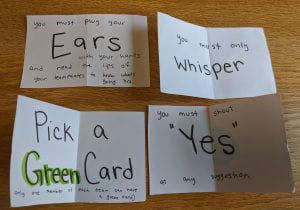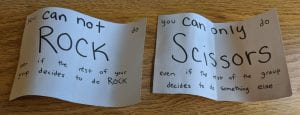Something that caught my interest during class, was whenever someone took a very simple game and created an entirely new experience by changing one mechanic of the game. Some examples that come to mind are the giant joystick by Mary Flanagan and the Octopad by Patrick Lemieux, an 8-person game controllers where each person can only push one button. I wanted to do something similar with the very simple game of Rock Paper and Scissors. I wanted to see this game played with more collaboration and chaos. So, I decided to merge the game of Rock Paper and Scissors with the game Mountains of Madness.
Mountains of Madness is a boardgame I discovered about a month ago. The aim of the game is to have a team of five players reach the top of the mountain alive with as much treasure as they can. To do so, the players must work together against a bunch of mini challenges. In order to beat these challenges, communication is the most important thing. If the team ever fails a challenge, one of the players gets a madness card. Madness cards impair that member’s ability to communicate in some way, which make the game progressively harder the more and more you fail challenges. Each player can have up to three madness cards each, which make the game very exciting, crazy, and chaotic.
My combination of Rock Paper and Scissors and Mountains of Madness, called Mad Rock Paper Scissors, is best played with 6, 8, 10, or 12 players. The group of players is split into two teams. In order to win each member of one team must decide on an action to use on the other team, however, they must all perform this one action in sync in order to get the point. For example, if team 1 all perform “rock” and team 2 all person “scissors”, team 1 wins. But if 2 members of team 1 perform “rock” and the other 2 members of team 1 person “scissors”, that team automatically loses.
The game consists of at least three rounds. Before each round, each team has 45 seconds to discuss what action they will perform. During the first round, neither team has a madness card. During the second round, each team has one madness card that each team member shares. During the third round and onward, each team member will have their own madness card. The distribution of the madness card is random before each new round. Like Rock Paper and Scissors, it runs on a “best out of three, best out of five” method where the teams decide how long they want to play.
I do not own the game Mountains of Madness, so I was unable to use the real madness cards. Instead I made my own and formatted them to fit the game of Rock Paper and Scissors better. There are blue and green cards. Blue cards are normal madness cards. Green cards are more restricting. Green cards restrict what action a single player can perform. For example, a green card can tell the player that they can only do rock. This player would have to convince their team to person this single action. Each team can only have as most one green card, because too many green cards can lead to impossible outcomes. If two team members both have green cards and one member can only do rock while the other can only do scissors, then the entire team is doomed to fail.
When I presented this game in front of the class, it is interesting to note groups would perform fake hand gestures during the discussion period in order to deceive the other group. This interaction between players was a fun addition I didn’t anticipate.
Examples of Blue Cards:

Examples of Green Cards:

